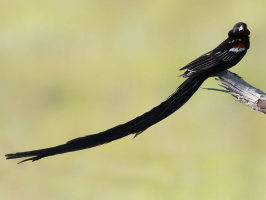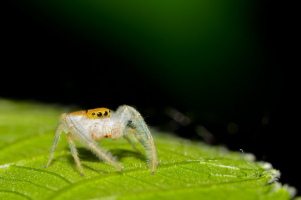Top 15 Most Amazing Camouflage Animals
Some creatures aren't just aware of their surroundings; they are them. At least, that's what their adversaries believe. Camouflage is an old art form, and ... read more...animals all around the world rely on it to survive. Blending in with one's environment might make the difference between eating and be eaten, whether it's a gecko blending into bark or a jaguar blending into vegetation. In celebration of the animal kingdom's beauty, here are the top 15 most amazing camouflage animals.
-
Chameleons, whose color-changing abilities have made them symbols of adaptation, are one of the most recognized animals for camouflage. The chromatophore, a colored cell layered under the translucent outer skin of chameleons, is the key. Contrary to common perception, chameleons do not change colors to blend in with their surroundings. Scientists believe that they alter hues to communicate.
When chameleons are fearful, they darken their colors, whereas when they are delighted, they brighten them. Some colors indicate that the animal is mate-ready. Chameleons also change hues to maintain their body temperature. They change their hue to control the amount of heat they collect from the sun. Don't worry if the true explanation behind chameleons' famed ability to change hues startled you. Numerous other species can disguise themselves as pros. As its name suggests "chameleon" can transform into many different colors making it the most amazing camouflage animals.
Scientific Name: Chamaeleonidae
Distribution: Africa, Madagascar, southern Europe, and across southern Asia as far as Sri Lanka

treehugger.com 
a-z-animals.com -
If you're a hungry bird, good luck locating any common baron caterpillars in western Malaysia if you're a bird. Other butterfly larvae can mix in with nearby flora, but few can blend in as well as the baron. The intricate patterns and colors of baron caterpillars were developed only for the sake of concealment from predators. This increases their chances of living long enough to mature into common baron butterflies and hence reproduce. It is also one of the most amazing camouflage animals that will make you look twice.
Baron caterpillars are native to India and Southeast Asia. When the monsoon rains began to fall, the mango trees in the garden began to house a very fragile lifeform: Common Baron Butterfly eggs. The tiny water-drop-like eggs hatch into voracious young caterpillars who devour everything in their path. They molt several times while in the larval phase, growing longer and plumper. It gets more difficult to identify them as they blend into the background and become one with the mango leaf that serves as their habitat. The caterpillar is particularly striking, with a yellowish-white spine and a bristling look. This causes friction with mango growers, which the baron's disguise abilities can help them avoid.
Scientific Name: Euthalia Aconthea
Distribution: Native to Sri Lanka, India and southeast Asia
Size: 6 inches–8 inches
treehugger.com 
butterflycircle.blogspot.com -
Coral reefs are harsh environments, so people frequently utilize disguises to keep safe. The pygmy seahorse is particularly good at this. Pygmy seahorses, as their name implies, are small fish that blend in with their surroundings because of their size and camouflage. Bargibant's pygmy seahorse is so well hidden that it was only identified when a host gorgonian was taken and inspected by marine researcher George Bargibant.
This little seahorse is less than an inch long and studded with tubercles, which are spherical protuberances that resemble the coral it lives in. This species is usually one of two colors: purple with pink tubercles or yellow with orange tubercles, depending on the host gorgonian’s color. It fits in so well that humans only noticed it after it appeared in an aquarium among wild-caught coral. It is impossible to distinguish which is a coral reef and which is a Pygmy seahorse, which is why it becomes the most amazing camouflage animals.
Scientific Name: Hippocampus Bargibanti
Distribution: Found in Southeast Asia in the Coral Triangle area
Size: 0,55 inches–1,06 inches
treehugger.com 
oceana.org -
The curve of its tail gave this gecko its common name, as it did for all leaf-tailed geckos. Because a flap of skin (known as a dermal flap) circles its whole body, it may be dubbed a "leaf-shaped gecko." It can take on the appearance of a leaf or a bit of bark thanks to its adaptability. The flat body of the lizard is mottled with brown, tan, light grey, and black. It resembles the mossy tree trunk on which it is perched. It has wide yellow eyes with an oval pupil, which are ideal for locating prey at night.
Mossy Leaf-Tailed Gecko are only active at night and are quite hard to detect during the day. They blend perfectly with their surroundings thanks to their cryptic coloration, flat appearance, and immobile resting stance. They spend the majority of the day lying vertically on tree trunks, heads down. Mossy Leaf-Tailed Gecko will leave their daylight resting areas and proceed in quest of prey throughout the night. In the wild, female leaves consume a lot of snails to replace the calcium they lose during egg formation. When served snails, males rarely eat them. This food choice is one of the few documented examples of a species' sexes consuming different diets.
Scientific Name: Uroplatus Sikorae
Distribution: Madagascar
Size: 6 inches–8 inches

treehugger.com 
tortoisetown.com -
Another of the most amazing camouflage animals is the Eastern Screech owl. When it hides in the hollows of trees, its brown, gray, and white coloration mix in flawlessly with the bark, making it almost invisible. Feathers protrude from its head, breaking up its form and making it more difficult to discern.
This robin-sized nightbird may be found throughout most of the eastern United States, including city parks and leafy suburbs, where many humans are unaware they have an owl as a neighbor. The owl spends the day resting in holes or deep cover and only comes out to hunt at dusk. Despite their name, screech-owls do not shriek; instead, their vocalizations consist of whinnies and mild trills. The "red morph" or "rufous morph" of the Eastern screech owl has a more reddish-brown color. Eastern Screech owl hide among pine trees and shifting leaves, giving them the same level of camouflage as their gray counterparts.
Scientific Name: Megascops asio
Distribution: Eastern North America, from Mexico to Canada
treehugger.com 
audubon.org -
Although it is not an owl, the tawny frogmouth has a similar camouflage pattern to the Eastern screech owl. It, too, is colored to fit in with the trees it frequents. The tawny frogmouth, on the other hand, has a unique ability to imitate tree branches. The tawny frogmouth can easily make itself practically unnoticeable once it closes its eyes and tilts its head back, thanks to its incredible ability to stay stone-still for lengthy periods and its dexterous feathers that can be flattened.
Nighttime insects, worms, slugs, and snails make up the majority of the Tawny Frogmouth's diet. Also eaten are small animals, reptiles, frogs, and birds. The majority of food is collected by leaping from a tree or other lofty perch to the ground. These animals can even discover food while hiding in plain sight. They don't fly or grab prey using their talons. Instead, they sit and wait for prey, mostly insects, to approach them while remaining motionless. Do you see the image that the Toplist gives? It is difficult for humans or predators to recognize the tawny frogmouth because it looks like a tree, making it one of the most amazing camouflage animals.
Scientific Name: Podargus Strigoides
Distribution: Throughout Australia, including Tasmania.
Size: 34cm to 53cm
australian.museum 
treehugger.com -
When snorkeling in the Indian or Pacific Oceans, keep an eye out for coral reefs that are staring back at you. You may be looking at a stonefish, the world's most poisonous fish. Their venom is another prominent defensive mechanism. They have 13 strong dorsal spines that contain a deadly neurotoxin that, if trodden on, may kill humans. Stonefish are masters of amazing camouflage and can blend in so perfectly with their surroundings that their prey, predators, and even human SCUBA divers have trouble seeing them at all.
This monster comes in a variety of kinds, but they all employ the same camouflage strategy. The appropriately named stonefish mixes in with a variety of reefs and rocks to successfully lurk on the bottom, ready to ambush food thanks to its lumpy, encrusted look. While this camouflage protects them from predators, it is mostly used to help stonefish ambush their meal. Other reef fish and certain bottom-dwelling invertebrates are eaten, although they are not aggressively pursued. Instead, they sit and wait for dinner to arrive. Stonefish strike when their potential meal is less than a body length away after waiting for hours. Their muscular jaws and big lips provide so much pressure on their prey that they can simply suck it down and consume it whole.
Scientific Name: Scorpaena Horrida
Distribution: In the coastal regions of the Indo-Pacific.
Size: 30cm to 40cm

treehugger.com 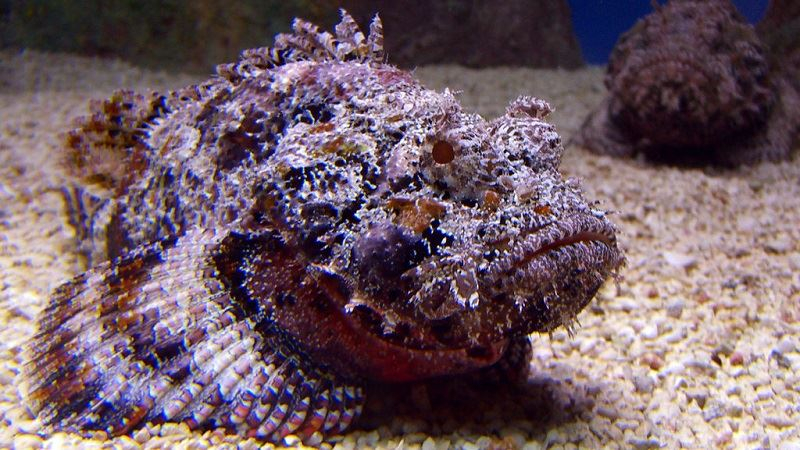
-
Like the Common Baron Caterpillar lurking among the leaves, Katydids are also one of the most amazing camouflage animals. Don't worry if you don't spot both katydids in this shot right away. Their leaf-like bodies also aid them in avoiding many birds, frogs, snakes, and other predators found all over the planet. The flounder that lives on the ocean floor has eyes that are entirely above, on the same side, and defies the law of symmetry.
Katydids, often known as bush crickets, are nocturnal insects. To be safe during the day, they adopt a diurnal roosting posture (a day resting position) that enhances their ability to blend in with their environment.
However, not all katydids are adept at hiding. On rare occasions, a genetic mutation causes a katydid to become bright pink, making it easier to spot among the green leaves.Scientific Name: Tettigonia Viridissima
Distribution: Found on every continent except AntarcticaSize: 0.2 inches–5.1 inches

treehugger.com 
candide.com -
The flounder that lives on the ocean floor has eyes that are entirely above, on the same side, and defies the law of symmetry. Flounder skin color may vary to elude predators or disguise prey, in addition to their unusual eyes. The upper skin is often dark brown, like muck, while the bottom skin is white, like light shining into water. They lie on the seafloor, their tiny bodies hidden behind a layer of sand with just their eyes visible. It protects them from predators while allowing them to ambush food such as shrimp, worms, and fish larvae.
When they are larvae, flounders have one eye on each side of their heads. One eye moves to the other side as they metamorphose, bringing both eyes together. This is how they can swim and conceal themselves while officially on their sides, with both eyes gazing up.
Distribution: Found at the bottom of oceans around the world; some species will also enter estuaries
Size: 20cm to 60cm
treehugger.com 
en.wiktionary.org -
Nightjars are nocturnal birds of modest size that may be found almost anywhere. They're known as "goatsuckers" because of a popular urban legend that they take goat milk. (They don't; they merely consume the insects that goats attract.) Because they build their nests on the ground, they are easy prey, which is why they must hide. Nightjars camouflage skills are due to their intelligence and strategic thinking, rather than any species-specific coloration. Each bird has its own distinct appearance, and it selects its nesting place depending on what would best complement its unique markings. This will assure their own and their offspring's survival.
Two possibilities for how nightjars gain this capacity were presented in research released in 2017. The first is that they are conscious of their physical appearance. Alternatively, the birds may have learned which backdrops are most efficient for camouflaging themselves through time and have stuck with them.
Scientific Name: Caprimulgus Agyptius
Distribution: In south west Asia and north Africa and winters in tropical Africa
Size: The length is 25 cm, and the wingspan 55 cm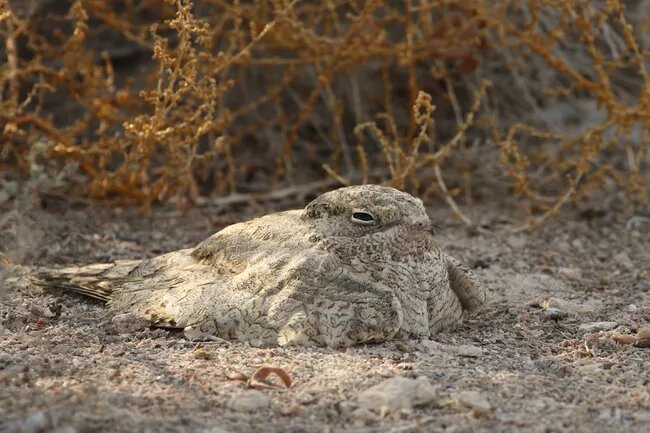
treehugger.com 
-
The bright white coat of the Arctic fox may attract our attention because of its beauty, but it has the opposite effect on tundra predators. This excellent outfit allows the fox to blend in with the white snow, shielding it from eagles, polar bears, and wolves. It also keeps it warm in temperatures as low as 58 degrees below zero, thanks to the fur. What happens, though, when the temperature heats up and the snow melts? The Arctic fox sheds its white coat and replaces it with a brown and blond one as the seasons change, allowing it to blend in with rocks and plants.
These colors aid foxes in their hunting of rodents, birds, and even fish. This is what makes them one of the most amazing camouflage animals and dangerously However, prey might be sparse on the ground in the winter. Arctic foxes will follow the region's top predator—a polar bear—to eat the leftover leftovers from its kills at such times. When veggies are available, foxes will eat them as well. This fox's broad tail, like a cat's, assists with balance. In cold weather, however, an arctic fox's tail (or "brush") is very valuable as a warm blanket.
Scientific Name: Vulpes Lagopus
Distribution: Native to the Arctic and common throughout the Arctic tundra biome.
Size: 46cm to 68cm

treehugger.com 
arctictoday.com -
The jaguar, the world's third-biggest cat, prefers deep jungles and marshes. Its tawny speckled coat makes it immediately identifiable to humans, but harder to find for other animals. The design helps the jaguar blend in with a variety of backdrops, including tree branches and long grass.
Because of its similar patterning, the jaguar is easily confused with cheetahs and leopards. The jaguar's camouflaging tool is distinctive because of its irregular rosettes (circular marks) and little spots inside them. Unfortunately, the markings on jaguars haven't been enough to keep them safe from their most dangerous predator: people. Jaguar were once found throughout North and South America, but are now confined to the latter, as well as a few Central American holdouts and probably a few in Mexico. In 2018, one of the last wild jaguars in the US was killed.
Scientific Name: Panthera Onca
Distribution: From Mexico through Central America to South America
treehugger.com 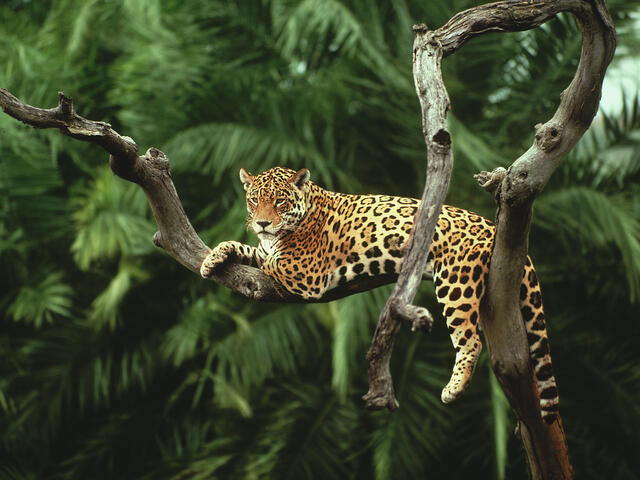
www.worldwildlife.org -
While most creatures require a certain background to be successful, some are so well camouflaged that they may be detected practically everywhere. Stick insects, for example, have twig-like bodies that allow them to become nearly invisible just by remaining motionless.
Stick insects are found all throughout the world and range in size from one to twelve inches. They are usually brown or green in color and freeze when threatened, swinging to simulate a limb blowing in the wind. That isn't to suggest they can't assert themselves. To ward off would-be predators, the American stick insect, for example, can spray a weak acid from two glands in its thorax. It can burn and possibly cause temporary blindness if it goes into a person's eyes.
Scientific Name: Phasmatodea
Distribution: Found on all continents except Antarctica
Size: 0.6 inches to 25 inches
treehugger.com 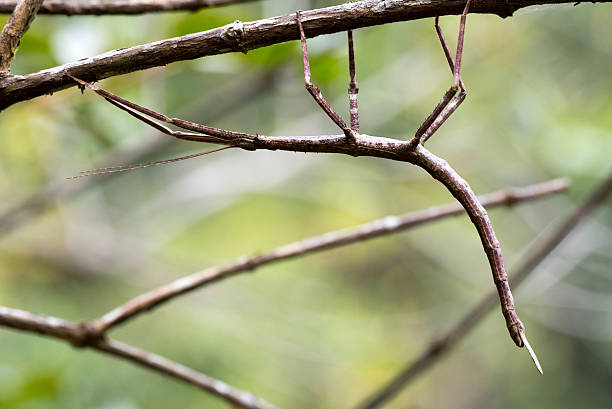
istockphoto.com -
A cuttlefish's capacity to change colors to match its environment has earned it the moniker "chameleon of the sea." Up to 200 color-changing chromatophores (pigment cells) are stacked atop other cells that reflect light in every square millimeter of their bodies. The cephalopod can use them to shift colors quickly and even construct chromatically complicated patterns. It also contains muscles that allow it to modify the texture of its skin from smooth to rough as needed, helping it to blend in with rocks and reefs.
Cuttlefish may change their appearance in ways that go beyond simple camouflage. It may "glow" with color and light, which hypnotizes fish, making them easy prey. This fish has a very special feature with the point of being able to use the colors it wants, so it is indispensable in the list of the most amazing camouflage animals ocean.
Scientific Name: Sepiida
Distribution: Present along the coasts of East and South Asia, Western Europe, and the Mediterranean, as well as all coasts of Africa and Australia, but are totally absent from the Americas
Size: 15cm to 25cm
treehugger.com 
highskyco.com -
Crab spiders have legs that stretch forth from the sides and can travel in any direction, just like crabs. The majority of them dwell in flowers and get prey by simply grasping and biting them. The white-banded crab spider is tiny and yellowish-brown in color. It has a somewhat greenish carapace with a broad whitish-yellow mid-band surrounded by darker, narrower yellowish-brown sides. Its eyes may be reddened, and its legs are all cream in hue. An abdomen with no markings is not uncommon, although it is more commonly characterized by a brownish-yellow V that converges toward the carapace and is made up of numerous spots or stripes.
This spider, like a chameleon, changes color to fit in with its environment. Thousands of tiny crab spiderlings hide among spring and summer blooms, preparing to use their muscular forelegs to catch insects. Because of a faint white or yellowish ridge on the spider's tiny "face," below its eight eyes, this species is sometimes dubbed the ridge-faced flower spider. The second popular name for this ridge is "white banded," since it is frequently white.
Scientific Name: Misumenoides Formosipes
Distribution: United States
Size: 0.2 inches to 0.44 inches
treehugger.com 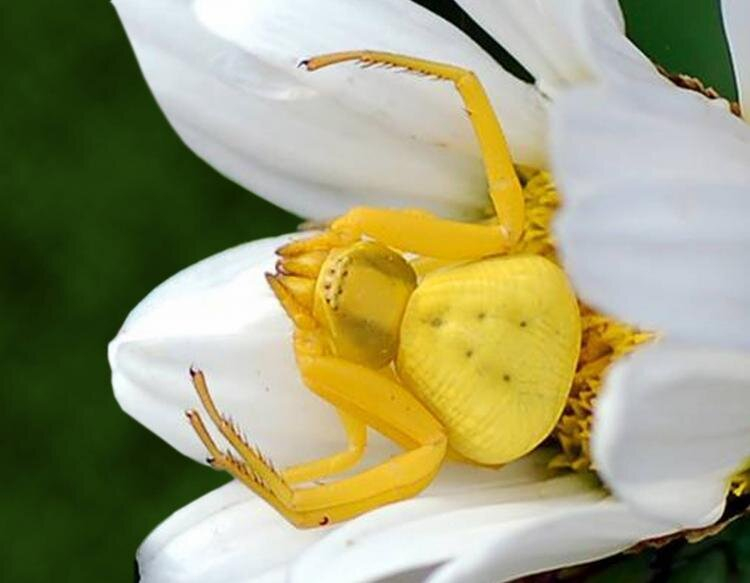
treehugger.com


























